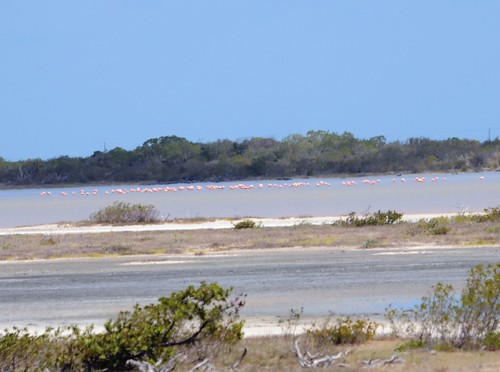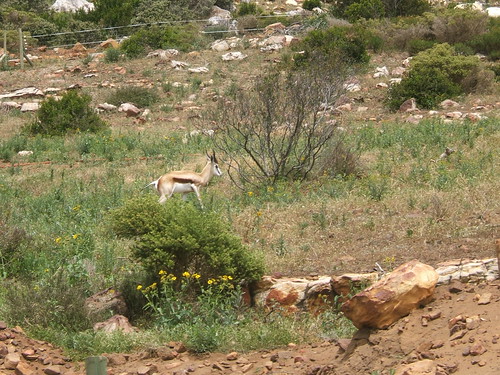- Prior to the pressures of modern society the earth was covered with a number of fully functional ecosystems;
- Modern human based pressures have damaged those ecosystems making them to a variety of degrees less effective;
- Restoration of those ecosystems is, to the extent possible, either morally desirable, necessary or potentially useful.
A flock of reintroduced Caribbean flamingos
As we saw yesterday reintroductions of endangered species can be extremely successful and can save entire species or populations. That being said conservation has of late moved well beyond simply breeding up rare animals and letting them go. In addition to the hard science involved in such breeding and releases (studbooks, head starting, inprinting) a more holistic approach is now often being seen.
Work is now being done to not just preserve wild areas or maintain species populations but to actively recreate lost ecosystems. Rewilding. in 2004 I visited an Earth Sanctuary just outside Sydney Australia. A big tract of land had been fenced in and all the feral animals (of which australia is plagued with an astonishing number) had been humanely removed. Instantly two things happened. The set upon local vegetation rebounded massively without introduced herbivores to trim it. Secondly a number of tiny marsupials; bandicoots, bettongs, potoroos et al began breeding hugely successfully without superior feral competitors and hunters to deal with. Introduced populations of critically endangered species thrived and multiplied with little human interference. The difference between inside and outside the enclosure was not just visible it was astonishing.
The model is being copied elsewhere. In Scotland, a multimillonaire called Paul Lister has reintroduced moose and wild boar to fenced off enclosures and hopes to follow up with Lynx, Brown Bear, Beaver and Wolf. South of Cape Town Antelope, Buffalo and Black Rhino pace in a fenced in game reserve. These projects are all massively laudable in my view - wild areas should be wherever possible maintained in as close to original condition as possible.
Reintroduced springbok, Solole Game reserve, Cape peninsula, RSA
One thing I do want to note on this topic relates to large predators. I've just finished The Jim Corbett Omnibus (a collection including Maneaters of Kumaon and the Man-eating Leopard of Rudraprayag - a review will be on the blog shortly). For those of you unfamiliar with Corbett he was a Hunter/Conservationist active mainly from 1910-1950 in Africa but primarily India and he is most famous as a uniquely effective hunter of man-eating big cats.
It is, for all we may point out the small statistical risk, a fact that many (but not all) large carnivores can and do kill people. Before anyone advocates the reintroduction of a large carnivore into someone else's backyard they really should read one of Corbett's accounts or something similar and try to put themselves in the shoes of one of the unfortunates Corbett couldn't save. As a Yellowstone ranger I saw on PBS the other week said "people want bears, just not in their yards". I'm not saying we shouldn't reintroduce big carnivores I merely point out that we should, before doing so, do everything we can in terms of appropriate education to minimise the risk to local people (for example bear education).
But even with that caveat, should we be settling for fenced in wilderness? If enclosed by wire can a rewilded area truly be wild? Earth Sanctuaries Limited, the listed company that maintained the Australian reserve I mentioned aimed to ultimately rewild 1% of Australia's land mass using its methods (in spite their visionary tactics, they didn't succeed I'm sad to report). What about the other 99%? Perhaps we should be fencing ourselves in, not our newly regained wildlands.


No comments:
Post a Comment